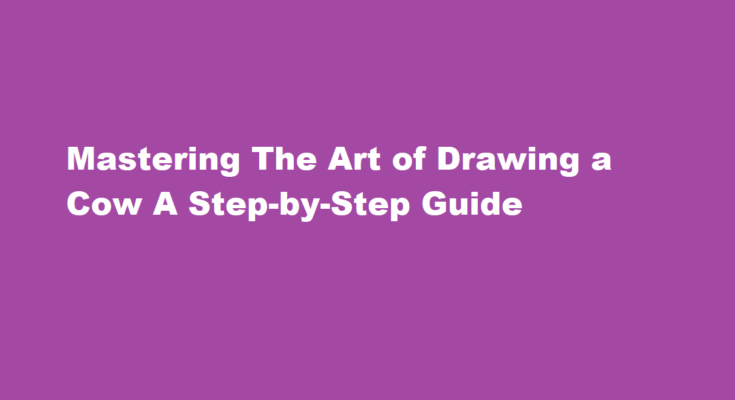Introduction
Drawing is a wonderful form of artistic expression that allows individuals to capture the beauty of the world around them. One common subject in the world of art is animals, and today, we will explore how to draw a cow. These gentle creatures are not only charming but also provide a unique challenge for artists due to their distinctive features. With the right guidance and practice, anyone can learn to draw a cow that truly captures its essence.
Materials You’ll Need
Before we dive into the step-by-step process of drawing a cow, let’s gather the necessary materials
- Paper Start with a clean, unlined sheet of paper. Choose the size that suits your preferences and drawing skill level.
- Pencils You will need pencils of varying hardness (HB, 2B, 4B) to create different tones and details.
- Eraser A good quality eraser is essential for correcting mistakes and refining your drawing.
- Reference Image Find a clear image of a cow to use as a reference. This can be from a book, magazine, or the internet.
Basic Shapes
Begin by drawing the basic shapes that will serve as your guide for the cow’s proportions. Start with an oval for the cow’s body. This oval should be slightly elongated horizontally. Next, add a smaller oval for the cow’s head at the front of the body. These shapes will form the foundation of your cow drawing.
Outline the Body
Using a light pencil (HB or 2B), carefully outline the body of the cow, following the shape you’ve drawn in the first step. Pay attention to the curvature of the oval and ensure it represents the gentle contours of a cow’s body.
Sketch the Head
Now, focus on the cow’s head. Sketch the head shape inside the smaller oval, taking care to capture the gentle curve of the snout. Add in the ears, which are typically large and pointy, and position them on either side of the head.
Add Facial Features
With the head in place, it’s time to add the cow’s facial features. Draw large, expressive eyes that are positioned on the sides of the head. Place a small, circular nostril at the tip of the snout. Add a smiling mouth by drawing a simple curved line. Don’t forget to give your cow some character by adding eyelashes if you’d like.
Outline the Limbs
Moving on to the limbs, draw four stout legs beneath the body. Cows have thick, sturdy legs, so make sure they reflect this. Pay attention to the joints and hooves at the bottom of each leg. Ensure the proportions are accurate by referring to your reference image.
Tail and Udder
Extend a curved line from the back of the cow’s body to form the tail. Cows usually have long, tufted tails, so make it look fluffy. Underneath the cow’s body, sketch an udder using gentle curves and lines. Remember to keep it in proportion with the body.
Add Details
Now that you have the basic structure, it’s time to add details to bring your cow to life. Pay attention to the cow’s fur, which is typically short and smooth. Use light, short strokes to create a texture that mimics the appearance of cowhide.
Shading and Depth
To make your cow drawing more realistic, add shading to create depth and dimension. Observe your reference image to identify areas of shadow and light. Use softer pencils (4B or darker) for shading and blend the tones using your fingers or a blending tool. Be patient and build up the shading gradually.
Final Touches
Take a step back and assess your drawing. Make any necessary adjustments to refine the details, fix any mistakes, and ensure the proportions are correct. Use your eraser to highlight areas that should be brighter.
FREQUENTLY ASKED QUESTIONS
What are the 7 ways for cows?
Ultrabac 7 is a 7-Way blackleg combination vaccine. Ultrabac 7 protects your cattle against the major blackleg type diseases, sudden death, and overeating. It includes these Clostridiales: chauvoei, septicum, novyi, sordellii, and perfringens types C & D.
What do cows eat in India?
Heifers and cows are fed grain mixed with hay, corn silage (entire corn plant chopped and fermented) and other feeds to create what farmers and nutritionists call a total mixed ration, or TMR. The TMR is made in a big mixer like the one below. The TMR is important because it ensures cows get proper nutrition.
Conclusion
Drawing a cow may seem like a challenging task, but with practice and patience, you can master the art. By following these step-by-step instructions and paying attention to detail, you can create a realistic and captivating cow drawing. Remember that practice is key, so keep refining your skills, and soon you’ll be able to capture the beauty of these gentle creatures on paper with confidence. Happy drawing!
Read Also : Breeding The Shugabush A Guide to Creating Musical Harmony



